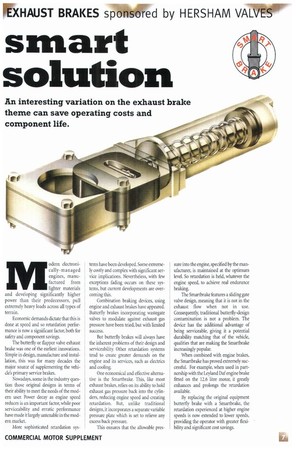smart solution
Page 121

If you've noticed an error in this article please click here to report it so we can fix it.
An interesting variation on the exhaust brake theme can save operating costs and component life,
IN odern electroni cally-managed engines, manufactured from lighter materials and developing significantly higher power than their predecessors, pull extremely heavy loads across all types of terrain.
Economic demands dictate that this is done at speed and so retardation performance is now a significant factor, both for safety and component savings, The butterfly or flapper valve exhaust brake was one of the earliest innovations. Simple in design, manufacture and installation, this was for many decades the major source of supplementing the vehicle's primary service brakes.
Nowadays, some in the industry question those original designs in terms of their ability to meet the needs of the modern user. Power decay as engine speed reduces is an important factor, while poor serviceability and erratic performance have made it largely untenable in the modern market.
More sophisticated retardation sys tems have been developed. Some extremely costly and complex with significant service implications. Nevertheless, with few exceptions fading occurs on these systems, but current developments are overcoming this.
Combination braking devices, using engine and exhaust brakes have appeared. Butterfly brakes incorporating wastegate valves to modulate against exhaust gas pressure have been tried, but with limited success.
But butterfly brakes will always have the inherent problems of their design and serviceability. Other retardation systems tend to create greater demands on the engine and its services, such as electrics and cooling.
One economical and effective alternative is the Smartbrake. This, like most exhaust brakes, relies on its ability to hold exhaust gas pressure back into the cylinders, reducing engine speed and-creating retardation. But, unlike traditional designs, it incorporates a separate variable pressure plate which is set to relieve any excess back pressure.
This ensures that the allowable pres sure into the engine, specified by the manufacturer, is maintained at the optimum level. So retardation is held, whatever the engine speed, to achieve real endurance braking.
The Smartbrake features a sliding gate valve design, meaning that it is not in the exhaust flow when not in use. Consequently, traditional butterfly-design contamination is not a problem. The device has the additional advantage of being serviceable, giving it a potential durability matching that of the vehicle, qualities that are making the Smartbrake increasingly popular.
When combined with engine brakes, the Smartbrake has proved extremely successful. For example, when used in partnership with the Leyland Daf engine brake fitted on the 12.6 litre motor, it greatly enhances and prolongs the retardation available.
By replacing the original equipment butterfly brake with a Smartbrake, the retardation experienced at higher engine speeds is now extended to lower speeds, providing the operator with greater flexibility and significant cost savings.








































































































































